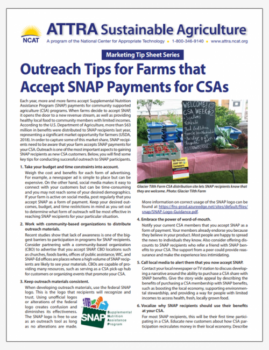Outreach Tips for Farms that Accept SNAP Payments for CSAs
NCAT Marketing Tip Sheet Series
By Tammy Howard, NCAT Agriculture Specialist, and Anna Goodrum, Montana State University Dietetic Intern
Introduction
Each year, more and more farms accept Supplemental Nutrition Assistance Program (SNAP) payments for community supported agriculture (CSA) programs. When farms decide to accept SNAP, it opens the door to a new revenue stream, as well as providing healthy local food to community members with limited incomes. According to the U.S. Department of Agriculture, more than $63 million in benefits were distributed to SNAP recipients last year, representing a significant market opportunity for farmers (USDA, 2018). However, in order to capture some of this market share, SNAP recipients need to be aware that your farm accepts SNAP payments for your CSA. Outreach to SNAP recipients is one of the most important aspects to gaining this new form of CSA customer. Below, you will find some key tips for conducting successful outreach to SNAP participants.
1. Take your budget and time constraints into account.
Weigh the cost and benefits for each form of advertising. For example, a newspaper ad is simple to place but can be expensive. On the other hand, social media makes it easy to connect with your customers but can be time-consuming and you may not reach some of your desired demographics. If your farm is active on social media, post regularly that you accept SNAP as a form of payment. Keep your desired outcomes, budget, and time restrictions in mind as you set out to determine what form of outreach will be most effective in reaching SNAP recipients for your particular situation.
2. Work with community-based organizations to distribute outreach materials.
Recent studies show that lack of awareness is one of the biggest barriers to participation in programs for SNAP recipients. Consider partnering with a community-based organization (CBO) to distribute outreach materials advertising that you accept SNAP. CBO locations such as churches, foods banks, offices of public assistance, WIC, and SNAP-Ed offices are places where a high volume of SNAP recipients are likely to see your materials. CBOs are capable of providing many resources, such as serving as a CSA pick-up hub for customers or organizing events promoting your CSA.
3. Keep outreach materials consistent.
When developing outreach materials, use the federal SNAP logo. This is the logo that recipients will recognize and trust. Using unofficial logos or alterations of the federal logo creates confusion and diminishes its effectiveness. The SNAP logo is free to use as an outreach tool as long as no alterations are made. More information on correct usage of the SNAP logo can be found here.
4. Embrace the power of word-of-mouth.
Notify your current CSA members that you accept SNAP as a form of payment. Your members already endorse you because they believe in your product. Most people are happy to spread the news to individuals they know. Also consider offering discounts to SNAP recipients who refer a friend on SNAP to your CSA. The support from a peer could provide reassurance and make the experience less intimidating.
5. Call local media to alert them that you now accept SNAP.
Contact your local newspaper or TV station to discuss developing a narrative around the ability to purchase a CSA share with SNAP benefits. Give the story wide appeal by describing the benefits of purchasing a CSA membership with SNAP benefits, such as boosting the local economy, supporting environmental stewardship, and providing a way for low-income individuals to access health, fresh, locally grown food.
6. Vocalize why SNAP recipients should use their benefits at your CSA.
For most SNAP recipients, this will be their first time participating in a CSA. Educate new customers about how CSA participation recirculates money into their local economies. Describe how they are supporting local farmers and environmental stewardship. Highlight the health benefits of eating fresh, locally grown food. Explain that while receiving unfamiliar foods may be intimidating, it will ultimately improve their culinary capabilities.
7. Communicate with SNAP recipients about what they should expect when they join your CSA and what your expectations are.
Ask new CSA members what their expectations are. Many individuals will not be accustomed to preparing as many fresh vegetables as they will be receiving. They may also be uncomfortable with new, unfamiliar foods. Provide resources for simple, quick recipes that highlight less-familiar produce. Some farms will even host cooking demonstrations or farm tours. Consider partnering with your local SNAP-Ed office to provide your SNAP customers with further educational resources. Ultimately, you want returning customers. Providing resources and open communication with SNAP CSA members will increase the chances of them coming back next season.
References
U.S. Department of Agriculture (USDA). 2018. Supplemental Nutrition Assistance Program Participation and Costs. May 4.
Further Resources
The CSA Farmer’s Nationwide Guide to Accepting SNAP/EBT Payments. 2013. By Zenger Farm, Portland, OR.
The CSA Farmer’s Guide to Accepting SNAP/EBT Payments. 2013. By Bryan Allen. Cooperative Extension System, Kansas City, MO. March.
Outreach Tips for Farms that Accept SNAP Payments for CSAs
By Tammy Howard, NCAT Agriculture Specialist and Anna Goodrum, Montana State University Dietetic Intern
Published June 2018
©NCAT
IP566
Slot 593
This publication is produced by the National Center for Appropriate Technology through the ATTRA Sustainable Agriculture program, under a cooperative agreement with USDA Rural Development. This publication was also made possible through a grant from the Montana Department of Health and Human Services – Nutrition and Physical Activity program.


